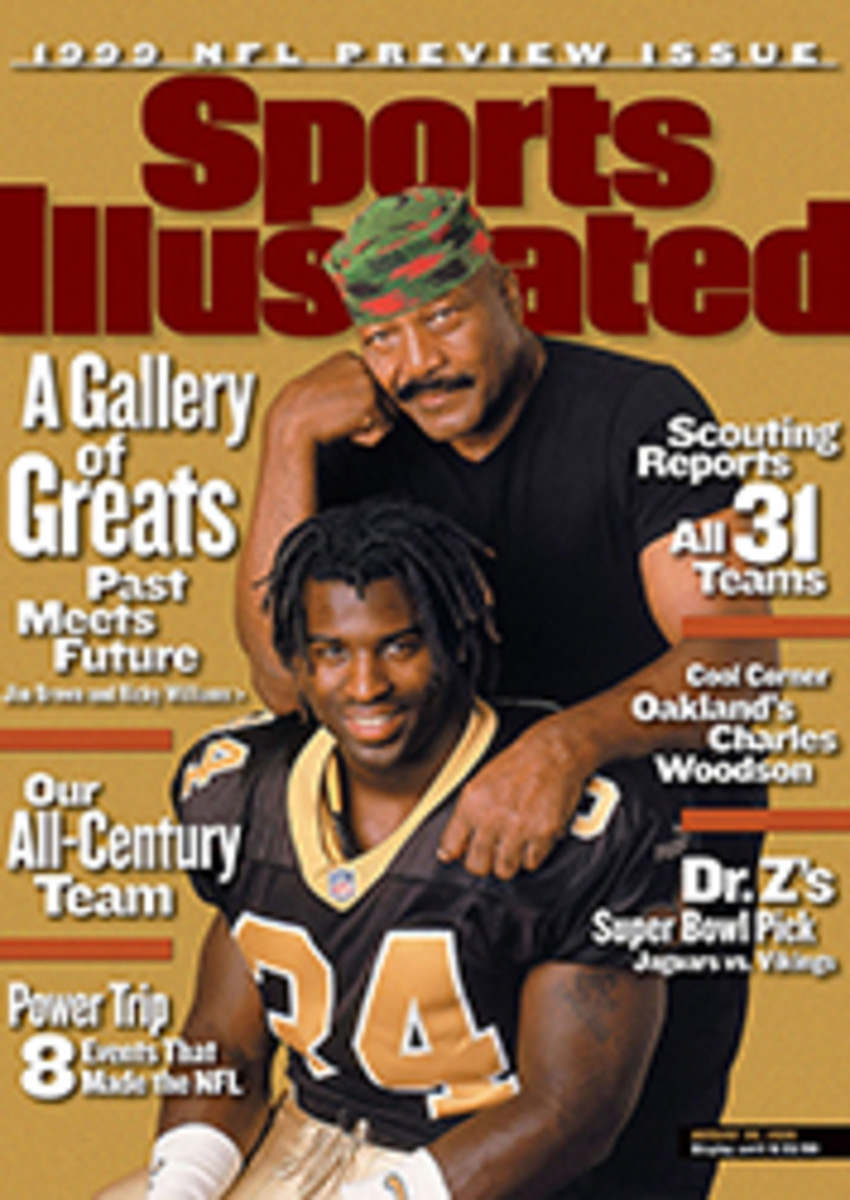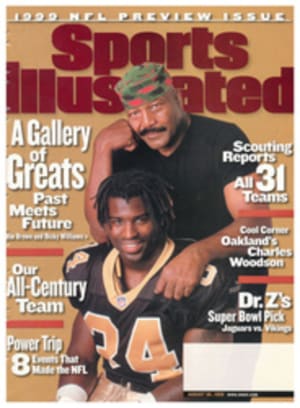
5 Cincinnati Bengals They'll go as far as running back Corey Dillon's legs can carry them, which, for the team with the AFC's worst record in the '90s, shouldn't be far
Bengals running back Corey Dillon showcased some of his best
moves inside Bally Total Fitness in his hometown of Seattle this
summer. Workout fiend Dillon, who gained 2,259 yards in his
first two seasons, discovered it wasn't a good idea to stand
still for more than a few seconds at Bally, or he would find
himself beset by people who wanted to talk about the Bengals.
"When you play for a 3-13 team you have to learn how to change
the subject quickly or make a move and get out of there," says
Dillon, who was drafted out of Washington in the second round in
1997. "It made me angry, because I didn't know what to tell
people."
As it turns out, Dillon may be just the guy to turn around
Cincinnati's fortunes. A chiseled 6'1", 225-pounder, he's a
battering ram who craves collisions and plays with the kind of
fervor that has given the Bengals some things they've been
missing for 10 years: a player to build around and some swagger.
"We're rebuilding the personality and attitude of the team
around Corey," says Cincinnati right tackle Willie Anderson.
"When he's done in this league, he'll have redefined who the
Bengals are, and he'll have done for power running what Barry
Sanders did for open-field running."
In 1997 Dillon broke Jim Brown's NFL rookie single-game record,
running for 246 yards on 39 carries in a game against the
Oilers. After his first season, in which he rushed for 1,129
yards, Dillon told a reporter--jokingly, he says--that he wanted
to run for 2,500 yards in '98. In print the remark came across
as serious. "After that defenders looked at me like they wanted
to kill me," he says.
They came close. Last year Dillon played with an assortment of
injuries, including a sprained toe, a bad shoulder, a bruised
back, a hip pointer and a kneecap that kept slipping out of
place. Still, he gained 1,130 yards in 15 games and had a 4.3
yard average. This year he could become the 11th back in NFL
history to rush for 1,000 yards in each of his first three
seasons. If he attains that number, the Bengals could climb out
of the AFC Central cellar. "For us to do well, Corey has to be
the focal point," says Cincinnati coach Bruce Coslet. Coslet's
thinking is that by controlling the clock with Dillon, the
Bengals can minimize exposure to their weaker areas, which are
essentially everything else.
In 1998, when Cincinnati went 3-13, the Bengals' defense ranked
28th and was last in the NFL in rushing yards and points
allowed. In the first quarter Cincinnati was outscored 113-26.
With their first-round draft pick, Oregon quarterback Akili
Smith, and their top wideout, the chemistry-killing Carl
Pickens, holding out, the Bengals will put their passing game in
the hands of Jeff Blake, a sporadic thrower. Pickens, a free
agent, has vowed never to play for Cincinnati again, but because
the club slapped its franchise-player designation on him, other
teams are wary about signing him since they would have to send
the Bengals two first-round draft picks or some other
agreed-upon compensation.
"I don't care how great Corey Dillon is," says Coslet, "if we're
down 21 points in the second quarter or if we can't open any
holes or keep defenses honest with our passing game, he won't be
a factor. No runner in this league can do it all by himself."
Cincinnati will try to keep defenses off balance by spelling
Dillon with the injury-prone Ki-Jana Carter. Still, Dillon will
get the bulk of the work; in fact, the Bengals would like to use
him 10 more times a game than they did in 1998, when he averaged
17.5 carries. He'll run behind a line that's so thin after
injuries to prospective starters Brian DeMarco (shoulder) and
Kevin Sargent (neck) that 366-pound Jamain Stephens, who was cut
early in camp by the Steelers for being, well, fat, is getting a
tryout. Cincinnati promptly issued Stephens jersey number 78,
the same number worn by Hall of Fame tackle Anthony Munoz.
Stephens will be assigned another number if he makes the roster,
but the move was a fitting metaphor for what has happened to
this team since its last Super Bowl appearance, in January 1989.
"It's been ugly, real ugly," says Anderson, a first-round draft
pick in '96. "It's embarrassing, too. I keep telling myself, We
just can't be this damn bad."
The numbers don't lie. At 48-96 the Bengals have the
second-worst record in the NFL this decade, better only than
that of the Rams. Dillon may be something special, but he's got
his work cut out for him.
--D.F.
COLOR PHOTO: STEPHEN DUNN/ALLSPORT Killing time If Dillon can eat up yards, Cincinnati won't have to expose its suspect defense as much.
COLOR PHOTO: DAVID COYLE
SCHEDULE
Sept. 12 at Tennessee
19 SAN DIEGO
26 at Carolina
Oct. 3 ST. LOUIS
10 at Cleveland
17 PITTSBURGH
24 at Indianapolis
31 JACKSONVILLE
Nov. 7 at Seattle
14 TENNESSEE
21 BALTIMORE
28 at Pittsburgh
Dec. 5 SAN FRANCISCO
12 CLEVELAND
19 Open date
26 at Baltimore
Jan. 2 at Jacksonville
FAST FACTS
1998 Record 3-13 (5th in AFC Central)
NFL rank (rush/pass/total): offense 19/17/17; defense 30/12/28
1999 Schedule strength NFL rank: 30 Opponents' 1998 winning
percentage: .446 Games against playoff teams: 3
OPPORTUNITY LOST
The Bengals will begin the season with seven consecutive games
against teams that did not make the playoffs last year, tied for
the longest such run of soft scheduling for any NFL team in the
past 10 years. But over the last 20 years only one of the seven
teams that were granted such an easy start produced a winning
record in that season.
Consecutive games W-L during
Team vs. nonplayoff teams that stretch Final W-L
1985 Bills 11 2-9 2-14
1980 Dolphins 9 4-5 8-8
1988 Redskins 8 5-3 7-9
1982 Bears 8 3-5 3-6*
1999 Bengals 7 ? ?
1998 49ers 7 6-1 12-4*
1982 Seahawks 7 3-4 4-5*
1980 Jets 7 1-6 4-12
*Strike-shortened season
PLAYER TO WATCH
If there's a tackler who can lift the Bengals out of their
defensive doldrums, it's second-year inside linebacker Takeo
Spikes. The 13th pick in last year's draft out of Auburn,
Spikes, whom coach Bruce Coslet refers to as a "guided missile,"
became the second rookie this decade to lead Cincinnati in
tackles. A ferocious hitter who was national defensive player of
the year at Auburn and who plays as if possessed by Bears Hall
of Fame linebacker Mike Singletary, the 6'2", 230-pound Spikes
finished his rookie season with 114 tackles, 31 more than any
other Cincinnati defender. It's fitting that Spikes's first name
means "great warrior" in Japanese. "There are some fine inside
linebackers in this league," says Coslet, "and in my mind he's
right up there with them."
PROJECTED LINEUP WITH 1998 STATISTICS
Coach: Bruce Coslet
Fourth season with Bengals (43-62 in NFL)
Offensive Backs PVR*
QB Jeff Blake 108
93 att. 51 comp. 54.8% 739 yds. 3 TDs 3 int. 78.2 rtg.
RB Corey Dillon 42
262 att. 1,130 yds. 4.3 avg. 28 rec. 178 yds. 6.4 avg. 5 TDs
RB Ki-Jana Carter 227
2 att. 4 yds. 2.0 avg. 6 rec. 25 yds. 4.2 avg. 0 TDs
FB Brian Milne 309
10 att. 41 yds. 4.1 avg. 26 rec. 124 yds. 4.8 avg. 1 TD
Receivers, Specialists, Offensive Linemen
[PVR]
WR Darnay Scott 82 51 rec. 817 yds. 7 TDs
WR Willie Jackson 196 7 rec. 165 yds. 0 TDs
WR Stepfret Williams 280 6 rec. 81 yds. 1 TD
TE Tony McGee 257 22 rec. 363 yds. 1 TD
K Doug Pelfrey 233 21/21 XPs 19/27 FGs 78 pts.
PR Stepfret Williams 280 2 ret. 8.0 avg. 0 TDs
KR Tremain Mack 340 45 ret. 25.9 avg. 1 TD
LT Rod Jones 6'4" 325 lbs. 6 games 2 starts
LG Matt O'Dwyer[1] 6'5" 300 lbs. 16 games 16 starts
C Rich Braham 6'4" 305 lbs. 12 games 12 starts
RG Brian DeMarco[1] 6'7" 323 lbs. 16 games 9 starts
RT Willie Anderson 6'5" 340 lbs. 16 games 16 starts
Defense
LE John Copeland 5 tackles 0 sacks
NT Oliver Gibson[1] 15 tackles 2 sacks
RE Michael Bankston 70 tackles 4 1/2 sacks
OLB Steve Foley 15 tackles 2 sacks
ILB Brian Simmons 83 tackles 3 sacks
ILB Takeo Spikes 114 tackles 2 sacks
OLB Reinard Wilson 64 tackles 6 sacks
CB Corey Sawyer 10 tackles 1 int.
SS Myron Bell 49 tackles 0 int.
FS Greg Myers 78 tackles 0 int.
CB Artrell Hawkins 71 tackles 3 int.
P Brad Costello 10 punts 49.5 avg.
[1]New acquisition (R) Rookie (statistics for final college
year) *PVR: Player Value Ranking (explanation on page 122)

